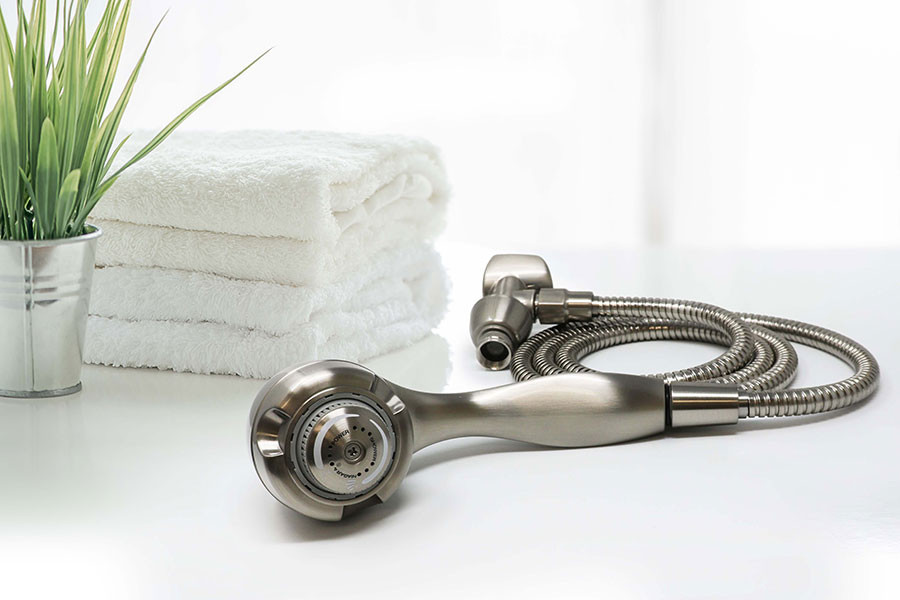Showerheads used to be simple—you turned them on and water came out. Maybe you could adjust the flow a little or splurge for some pulsing jets, but you didn’t have a lot of other options.
But like many plumbing features, showerheads have received a makeover. Today, you can choose between giant, ceiling-mounted rain showerheads, wall-mounted multi-jet spa systems, eco-friendly showerheads, and many more options.
If you’re feeling deluged by all of these choices, here are the top questions that will help you narrow down your options and find the type of showerhead that’s best for you and your family.
- How much do you want to spend? This is a multifaceted question because it not only takes into account your showerhead budget, but also your residence’s plumbing
If you’re a renter or a homeowner on a tight budget, you’ll want a showerhead that doesn’t require any replumbing. Fortunately, it’s usually easy to swap out a wall-mounted showerhead. The United States has standardized pipe sizes for showers, so you shouldn’t have to worry about a new showerhead fitting into the pipe that comes out from the wall—you can simply unscrew the old showerhead and screw in the new one.
-
Wall-mounted showerheads can cost as little at $5.19. For a few bucks more, you can get features like pulsing jets and flow restrictors. But if you want something more elaborate—especially if it entails moving your showerhead—it’s best to get an estimate from a plumber before you go shopping.
- Who will be using the shower? For a family bathroom, where mammals of all sizes use the shower, a good option is a wall-mounted unit with a sliding bar that raises and lowers the showerhead to different heights. The showerhead itself can have many configurations, including rain head, massaging, water-saving and more.
If you need to bathe small children or pets, a handheld model is a good choice. Or you can opt for a dual configuration that features a fixed showerhead—as simple or as fancy as you want—plus a handheld sprayer.
If you’re choosing a showerhead for your master bathroom, you might want to get more elaborate. For instance, multi-jet shower panel systems can create a spa effect, with targeted jets to massage your body and an aerated flow to rain down on your head. They’re all over Pinterest!
These systems are pricey, though, and you’ll likely need professional plumbing adjustments to accommodate the new system, such as wider pipes. Plus, depending on how many heads are in operation at once, you may use more water per shower—and energy to heat that water. Instead, think about combining two hot water-saving options, like a fixed rain showerhead on your ceiling and a handheld showerhead in the regular spot. This will give you a similar effect, without impacting your utility bills.
- What’s your water flow like? Since 1992, the U.S. Environmental Protection Agency has limited showerhead water flow to 2.5 gallons per minute (gpm). If your showerhead is older than that, the flow could be double that amount—meaning you could significantly reduce hot water usage if you replace it with a new model.
The easiest way to determine your shower’s water flow is to put a bucket under your showerhead, turn on your shower at the pressure you normally use, and then time how long it takes the bucket to fill to the one-gallon mark. It should take a low-flow showerhead at least 24 seconds to hit that mark. If your time is substantially less, you most likely have a high-flow showerhead. There are also inexpensive kits to make this measurement easier.If your time is substantially more, you may have low water pressure. The good news is that you can counteract that by choosing a showerhead specifically configured to increase water force and spray distance. Look for labels like “high performance,” “high pressure” or “ pressure-compensated”.
- How can you be more eco-friendly? You can choose showerheads with flows as low as 1.0 gpm, which can save substantial amounts of water. A 10-minute shower with a 2.5 gpm showerhead use 25 gallons, while a shower with a 1.0 gpm showerhead only uses 10 gallons.
Choosing a lower-flow showerhead doesn’t mean you’re relegated to a wimpy wisp of water every time you shower, though. The key is selecting a head that’s best for your needs.
Aerating showerheads mix water with air, creating a mist-like spray. This is a good choice if you like steamy, rainwater-type showers. Laminar-flow showerheads are more like traditional models, with streams of water coming out of numerous nozzles. They’re a good option if you like a stronger flow.
No matter what your situation is, there’s a showerhead that’s right for you. Check out our Marketplace for the best prices, instant rebates, and free shipping on water-wise showerheads for your home.
 US Dollar
US Dollar


